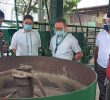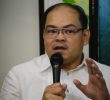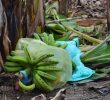The opposition of Apo Adoc triggered sympathy and support from indigenous people’s support groups, lumad organizations and environmental advocates.
In October 2007, Pasaka leaders and officers of the Solidarity Action Group for Indigenous Peoples (SAGIP) trooped to the office of the NCIP in Davao to confront NCIP officials about the project.
.jpg)
Apo Adoc Puroc in fervent prayers during the ritual at Tudaya Falls in November 2006. The old man of Sitio Tudaya denied signing documents that certify the community’s Free and Prior Informed Conset (FPIC) for Hedcor’s hydroelectric power project. “Selling out lands is prohibited by their forebears,” he says, pointing to “outsiders” as the ones that granted consent to the project. (davaotoday.com file photo by Cheryll D. Fiel)
Mel Elio, a Bagobo chairperson of Pasaka, questioned NCIP Director Roque Agton in a dialogue about the process of consultation by Hedcor in Tudaya.
Agton said they had conducted consultations with people in the area 20 times.
�But what use were these consultations if they were being controlled by Hedcor?� asked Norma Capuyan, a leader of the group Apo Sandawa Lumadnong Panaghiusa during the dialogue.
Capuyan accused the company of backing the deployment of more armed paramilitary units like the Civilian Armed Forces Geographical Unit (Cafgu) and Civilian Volunteers Organization (CVO) sowing fear among residents during the consultations.
At present, Hedcor had finished the roads leading to the project, the pipeline tunnels, although it may take three years yet for everything to finish and for operations to start.
Rivera allayed fears that the construction of the project would result to environmental degradation.
�It’s not going to be as destructive as how they perceive it. Those water pipelines will be installed in tunnels. So they can still keep the trees,� Rivera said.
He said that in the ECC, the company also assured that it will develop a plan to reforest the area, as well as provide adequate relocation and compensation program.
Its implementation will be in coordination with the government agency concerned.
Rivera urged the groups to look at the positive side of the project. He pointed out that the company assured that residents will be given preference in their hiring of employees for the construction of the plant.
He said, another benefit is the electrification of the community.
�Then, they can live like one of us because they will soon have electricity, free water, and all amenities. Soon, they will have TV sets in Tudaya,� he said.
But Dulphing Ogan of Kalumaran, a federation of lumad organizations in Mindanao, said the company is being �absurd.�
�Why do they have to give something that the lumads already have even before they came?� Ogan said, referring to the lumads’ ancestral land. �The truth is they are even stealing away their lands,� he said.
Recently, a group composed of Tagabawa lumads of Tudaya called Sinubadan ka mga Lumad Bagobo Mekatanod (SiLuBaMe) questioned and protested the construction of the hydropower building of the project within the Mt. Apo National Park, during the consultation.
Local officials of Davao del Sur present during the consultation said they will review the memorandum of agreement between the community and Hedcor and will hold committee hearing in view of the group’s complaints. (Cheryll D. Fiel/davaotoday.com)
Indigenous Peoples









